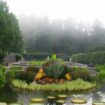
We are reader-supported and may earn a commission on purchases made through links in this article.
It was 8:30 in the morning and we should already have been feeling the warmth of the morning’s sun upon us, but an untimely fog had blanketed the hills of the Blue Ridge countryside and it had yet to burn off, fighting the arrival of day every step of the way.
We stood on the esplanade, staring out across the grey-shrouded lawn as the outer edges of the elaborate towers, intricate spires, and steeply-pitched roofs began to define themselves. The French-gothic inspired Château with its perched gargoyles began to emerge from its somber curtain like the opening scene of a James Whale-directed film.
Best Tips & Tools to Plan Your Trip
It’s difficult to describe the initial reaction to our first sight of the Biltmore, George Washington Vanderbilt’s majestic estate located in Western North Carolina in the midst of the Blue Ridge Mountains. The European-style mansion dominates the sky-line. It is so immense that, initially, it was challenging to concentrate on any one focal point.
Eventually, as designed, the five stories of the entrance tower demanded our gaze. It is at once both foreboding and inviting. What is this overwhelming mountain of limestone and what is it doing on a hill top in the backwoods of Appalachia?
Built during a period of massive wealth inequality, Biltmore represents a lifestyle available exclusively to America’s wealthiest families for a brief period of history at the turn of the twentieth century. George Washington Vanderbilt achieved his fortune fortuitously by being the youngest grandson of shipping and railroad magnate Cornelius Vanderbilt.
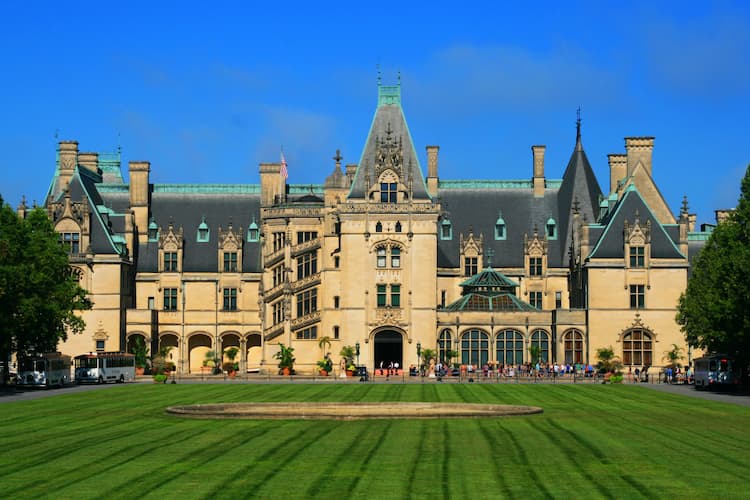
The Vanderbilts
Cornelius Vanderbilt, known universally as “The Commodore”, at the age of 16 took a few dollars borrowed from his mother, and within his lifetime transformed it into the largest private fortune in the world up to that time.
He began this fortune by running a small ferry between Staten Island and Manhattan, quickly expanding his modest ferry into a profitable shipping and steamboat business.
A shrewd and ruthless businessman, Cornelius eventually shifted his assets into America’s flourishing railroad industry, eventually creating one of the largest railroads in the New York Central. It was a move that proved to be prosperous.
At the time of his death in 1877, Cornelius Vanderbilt had turned that borrowed $100 into a fortune of approximately $100 million, making him the wealthiest person in the world.
His son William Henry Vanderbilt acquired his father’s fortune, doubled it through shrewd investments and was the richest American until his death in 1885. At which point, His estate was divided among his wife and eight surviving children, including the youngest, George Washington Vanderbilt III.
Studious and inquisitive, George found himself drawn to more academic pursuits. George became a patron of the arts. He was also a voracious reader, who could read and write in eight languages, eventually amassing a collection of 20,000 volumes.
When George was 26 years old, he discovered the resort town of Asheville, North Carolina, on a trip with his mother. He fell in love with the scenic beauty of the Blue Ridge Mountains and set out to create an architectural masterpiece that became the largest private residence in America.
At a time when most of the local residents lived their lives in rough cabins, the Biltmore represented largess at its pinnacle.
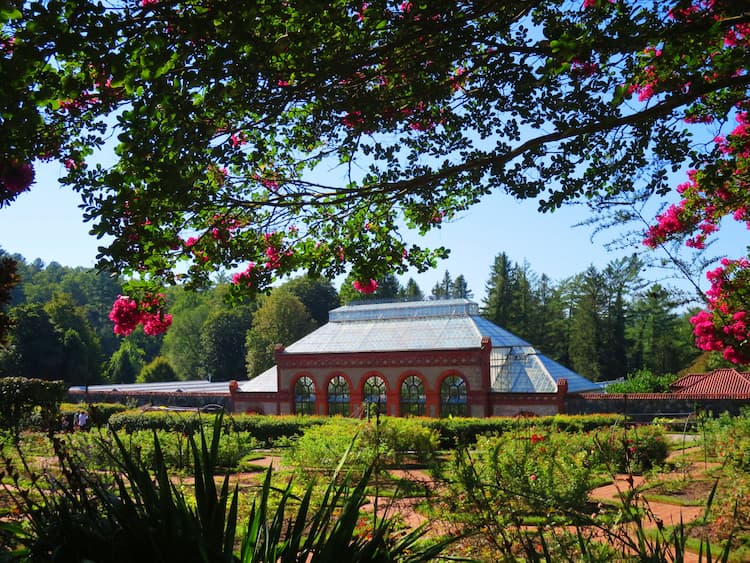
The Gardens
We had purchased are timed-entry tickets to the house the prior afternoon. With our inside tour not until midday, we began the morning exploring the gardens. Vanderbilt had hired the eminent landscape architect Frederick Law Olmsted, designer of New York City’s Central Park, to make the grounds as stunning as his new home.
We wandered into The Italian Garden, on a terrace below the chateau, the low-hanging mist created a grey ceiling under which the still waters of the symmetrical water-lily covered pools lay undisturbed like sheets of black glass. The surface only to be occasionally disturbed by colorful schools of Koi fish as they rippled the waters seeking some morsel.
As we admired the aquatic art of the garden, bees took advantage of the opening blooms of yellow, white and pink lilies as they tried to greet the reticent morning sun.
Around us angelic, chubby-faced marble cherubs attend to the garden and seemed to look affectionately down upon us.
Beyond the pools, we found walkways winding through flowering shrubs and trees that led us to The Walled Garden. This square, four-acre living portrait holds symmetrical flower beds with a central grape-covered arcade leading to the Conservatory.
As we strolled into the living pageantry, the sun magically burst through, evaporating the dreary haze, bathing the gardens in brilliant light.
Colorful Mexican Sunflowers, fiery Celosia, and auburn Cannas erupted in a vibrant tableau framed by an array of willowy ornamental grasses.
This fine display barely prepared us for what awaited in the Conservatory. Biltmore’s brick and glass-enclosed building shelters exotic and tropical plants from around the world. There are 6 rooms, starting with the central Palm Room, which rises a stunning 40 feet overhead and has several spectacular palm species.
However, I found the most remarkable room may very well be the Orchid Room. It features more than 500 plants displaying a palette of tints, hues and shades that would have made Van Gogh envious.
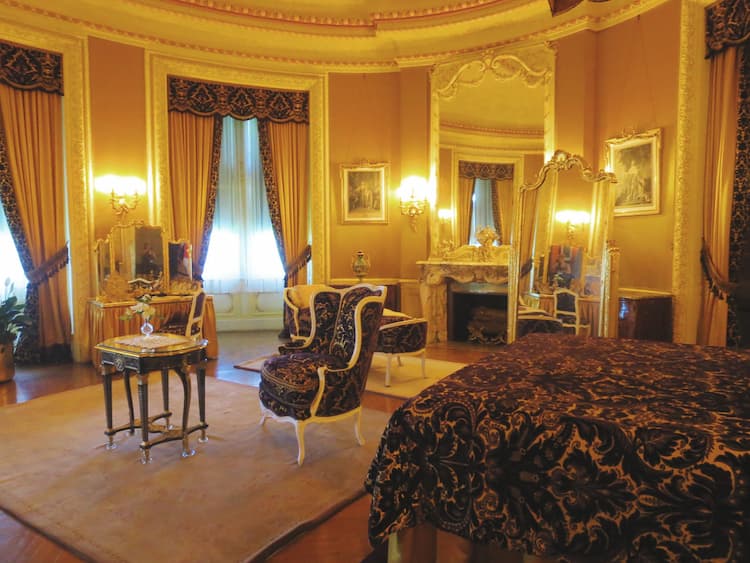
The House
Employing the skills of architect Richard Morris Hunt, It took George Vanderbilt and an entire community of artisans, craftsmen and laborers six years of construction to finish his home. He finally moved into it on Christmas Eve of 1895. The finished home contains more than four acres of floor space, including 35 bedrooms, 43 bathrooms, and 65 fireplaces.
We entered through massive, carved wooden doors which lead into a soaring atrium. It is an immense room that reminded me of the salon of an old world hotel. There, we were provided with an audio device that resembled a TV remote which provided running commentary as we toured the estate at our own pace.
To the right of the marbled hall, lies the octagonal sunken Winter Garden which is surrounded by stone archways with a ceiling of elaborate wood and glass. In the center, encircled by an array of tropical plants, is a marble and bronze fountain.
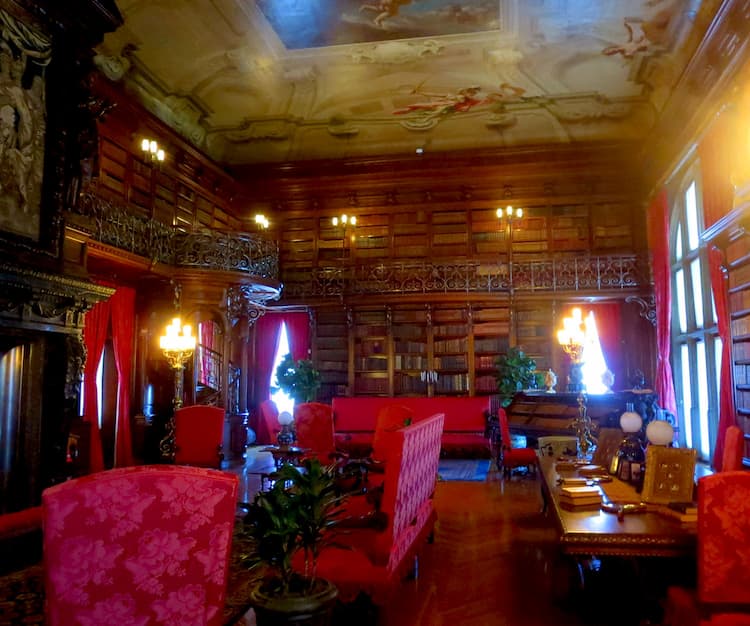
The most jaw-dropping room may very well be the immense banquet room. A seven-story high, barrel-vaulted ceiling creates a striking tableau. Walls lined with tapestries from the 16th century, framed by mounted animal specimens, flags, a pipe organ, a massive marble fireplace with three fire-boxes, and with a table capable of seating as many as 65 diners.
This room was intended to impress the unimpressible.
As we entered each succeeding room, our heads were in constant motion trying to take in both the ostentatious and nuanced décor. As I listened to the audio guide highlighting aspects of the estate, my eyes would wonder into the nooks and crannies trying to achieve some insight into the lives that had haunted these halls.
Each room had its defining aspects, such as two original Claude Monet paintings that hang side-by-side in the morning salon. The Tapestry Gallery, the longest room in Biltmore House, was designed to showcase a set of tapestries known as The Triumph of the Seven Virtues that were woven from wool and silk in the 1500’s. The music room with its unusual history.

During the winter of 1942, with world at war, an unusual array of guests arrived at Biltmore House. Accompanied by guards, 62 paintings and 17 sculptures from the National Gallery of Art were carried into the house and placed in the Music Room for protective custody.
I have to admit that I was both awed and envious of the library. The two-story Library contains over 10,000 volumes in eight languages, reflecting George Vanderbilt’s broad interests in classic literature as well as works on art, history, architecture, and gardening.
I wanted to step across the rope-barrier and reach out to the books, turn the pages, and discover exactly what type of books and stories intrigued George and whether we had similar tastes.
I had to content myself with simply admiring the countless volumes from a distance, many of which are said to be rare and valuable, housed in elegant wooden bookcases that reach from floor to ceiling.
We were told that the library also houses a concealed passageway that leads to the guest rooms, allowing for nocturnal visits without disturbing others.
The second floor revealed George and his wife Edith’s bedrooms. George’s dark bedroom – whose size rivals my first apartment – denoted his status with oversized furnishings and gold leaf on the walls.
George was a bachelor when he moved into his “castle”. It wasn’t until 3 years later that he met Edith Stuyvesant Dresser in Paris and brought her to North Carolina as his wife.
Edith’s bedroom has a decidedly French boudoir over-tone to it and is more airy. This style may have reminded her of her childhood in France with her sisters.
The balance of the bedrooms were for guests and came in a variety of styles.
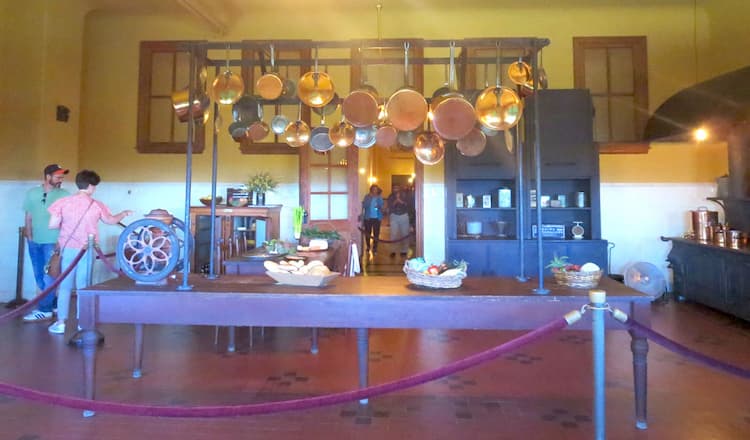
A Look at a Servants Life
The lower-level provided insight into the inner workings of what it took to run the massive household.
My wife and I are great fans of Downton Abby, especially the stories of the domestic servants and what it took to manage that household. The Biltmore was no different.
The Vanderbilt’s employed up to 40 staff members to maintain the estate and to ensure that each of their many hundreds of guest’s needs were met. The staff were provided room, board, and uniforms besides wages.
I found their bed-sitters to be austere, but functional. A far cry from the elaborate suites of the owners.
Unlike its British counterpart’s single kitchen, in Biltmore’s basement is a set of kitchens including a Pastry Kitchen, a huge Rotisserie Kitchen big enough for a whole hog, and the roomy Main Kitchen where most of the cooking for Biltmore took place.
Across from the kitchens was an elaborate laundry area. Vanderbilt embraced modern conveniences, so Biltmore was a fully electrified home, complete with electric lights, heating, and cooling systems, as well as appliances like refrigerators and washing machines.
A bowling alley, a gymnasium and indoor pool rounded out the lower level.
After Vanderbilt died in 1914, Edith Vanderbilt sold nearly 87,000 acres of estate land to the federal government. In 1930, during the Great Depression, the couple’s daughter, Cornelia Cecil, opened the property to tourists.
Members of the Vanderbilt family still own and operate the property, which today totals about 8,000 acres. They live here too, although not in the main house.
After the tour, we ate lunch at the Stable Café located, appropriately, in the original horse stables. As we dined, we discussed what we had just experienced.
The grandeur and luxury of the Biltmore is almost overwhelming. It represents a bygone era and of a life-style that only the top 1% ever experienced. It is also a man-made wonder that fascinates. It commands its summit while providing sweeping views of the neighboring area, almost as though it demands to be counted with the great mountains that surround it.
Out-sized at the time it was built, it is even more so today, overshadowing contemporary mansions. In its stunning mastery of the science of architecture, it really can best be described as a work of art in of itself.
Instantly striking and visually enthralling, visiting the Biltmore Estate gives visitors an opportunity to explore an American Downton Abby.
If you go:
The Biltmore Estate is located just outside of Asheville, NC.
Also on-site: several shops, restaurants, three hotels and the Biltmore Winery, all part of a commercial complex called Antler Village. Nearby, off the Biltmore property, is Biltmore Village, featuring more shops and restaurants.
Inspire your next adventure with our articles below:
Author Bio: Frank Hosek is an Illinois-based Director of Human Resources who revels in traveling with his wife, Kathy. He enjoys discovering new experiences, meeting the people that make those experiences enjoyable, and sharing their adventures. He is a freelance writer for newspapers and travel websites.

